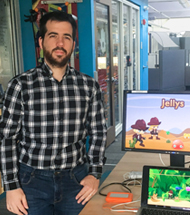El “lugar perfecto” para construir un videojuego que mejora la capacidad lectora de niños con dislexia
Mikel Ostiz, doctorando del ICS, realiza una estancia en la Universidad Carnegie Mellon para elaborar la versión con la que hará las primeras pruebas del juego

FOTO: Cedida
El ritmo afecta a la lectura y puede usarse como intervención para ayudar a personas con dislexia. Esta es la idea de la que parte el videojuego que Mikel Ostiz Blanco lleva a cabo en su tesis doctoral, que desarrolla en el Instituto Cultura y Sociedad (ICS) de la Universidad de Navarra, el Basque Center on Cognition Brain and Language (BCBL) y la Universidad de Vic.
Con el fin de avanzar en el desarrollo del juego y lograr una versión con la que poder hacer las primeras pruebas, Mikel realiza una estancia de seis meses en el Instituto de Interacción Humano-Computadora (Human Computer Interaction Institute) de la Universidad Carnegie Mellon (Pittsburgh, EE. UU.). Esta es posible gracias a dos ayudas de la Fundación Banco Sabadell y la Fundación Caja Navarra, que se suman a la beca de la Obra Social “La Caixa” que financia su tesis.
Según explica, “es el lugar perfecto para construirlo”, ya que este centro está considerado como uno de los más prestigiosos a nivel mundial en ingeniería aplicada a accesibilidad y a personas con necesidades especiales.
Mikel trabaja durante estos meses junto a Jeff Bigham, experto en interacción hombre-máquina, y Luz Rello, experta en aplicaciones informáticas para ayudar a personas con dislexia. También está ampliando sus conocimientos en los campos de evaluación de la usabilidad de una herramienta informática o el análisis de la interacción hombre-máquina.
“Es un entorno privilegiado para desarrollar una herramienta como la mía, de forma que el videojuego podrá alcanzar un nivel que no hubiera sido posible sin la estancia”, cuenta.
Mejorar el ritmo y la atención visualEl videojuego, al que ha llamado Jellys, pretende ayudar a mejorar la capacidad lectora de niños con dislexia a través del entrenamiento del ritmo y la atención visual. En él, se realizarán actividades en distintos “mundos” a los que viajarán los personajes, un chico o una chica exploradores. Los caracteres tendrán que encontrar y capturar los jellys a través de ejercicios de ritmo o atención visual.
De vuelta a Pamplona, Mikel realizará las primeras pruebas del juego junto con DISNAVARRA (Asociación de Dislexia de Navarra) para delimitar la interacción hombre-máquina de niños con y sin dislexia. La eficacia del juego se evaluará, finalmente, en un colegio de Pamplona durante el curso 2018-2019.
